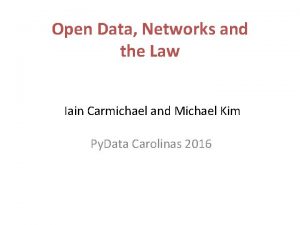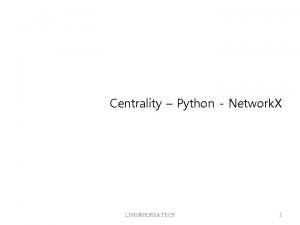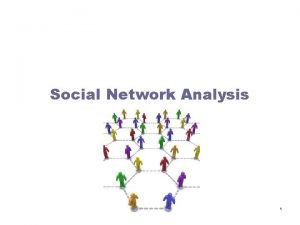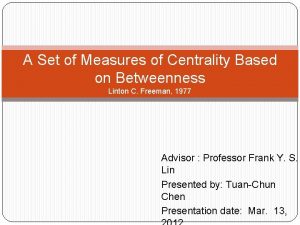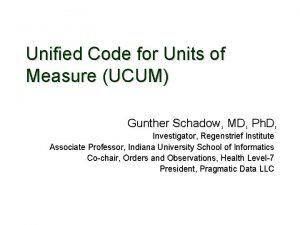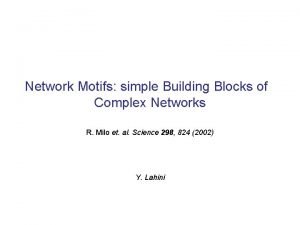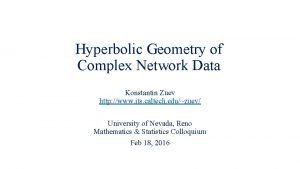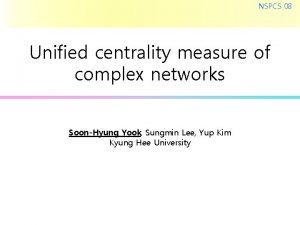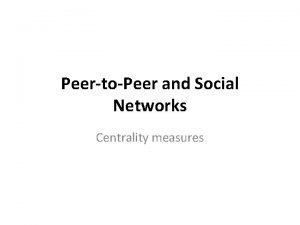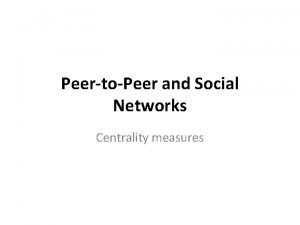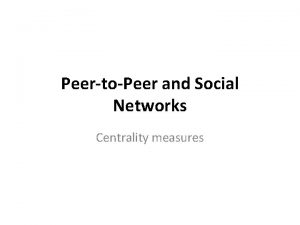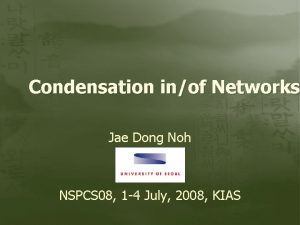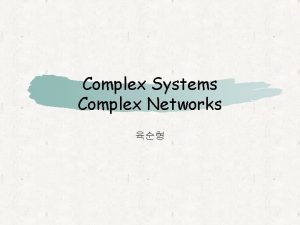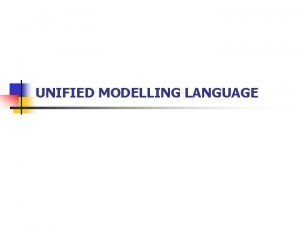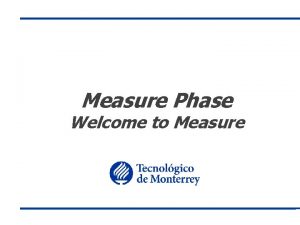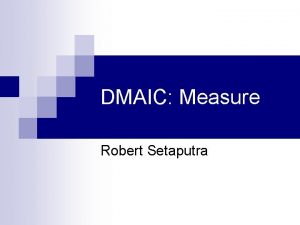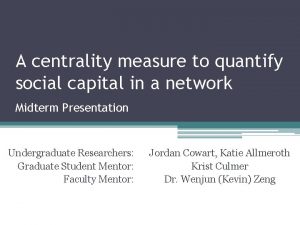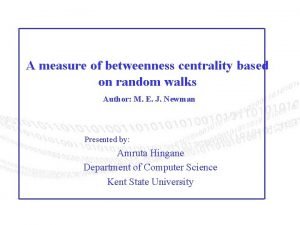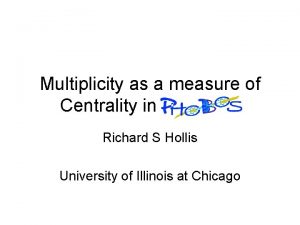NSPCS 08 Unified centrality measure of complex networks








![Various centrality and degree– lithality [Jeong et al. Nature 411, 41 (2007)] Various centrality and degree– lithality [Jeong et al. Nature 411, 41 (2007)]](https://slidetodoc.com/presentation_image/63b15e89da3012af571cb46c6b0f2dda/image-9.jpg)

![SPBC and RWC • SPBC and RWC [Newman, Social Networks 27, 39 (2005)] SPBC and RWC • SPBC and RWC [Newman, Social Networks 27, 39 (2005)]](https://slidetodoc.com/presentation_image/63b15e89da3012af571cb46c6b0f2dda/image-11.jpg)














- Slides: 25

NSPCS 08 Unified centrality measure of complex networks: a dynamical approach to a topological property Soon-Hyung Yook, Sungmin Lee, Yup Kim Kyung Hee University

Overview • introduction – centrality measure – interplay between dynamical process and underlying topology • biased random walk centrality – analytic results – compare the analytic expectations with well known centrality by numerical simulations • special example: shortest path betweenness centrality • first systematic study on the edge centrality • summary and discussion

Introduction • Many properties of dynamical systems on complex networks are different from those expected by simple mean-field theory – due to the heterogeneity of the underlying topology. – scale-free networks: P(k)~k-g • Is it possible to use such dynamical properties to characterize the underlying topology of given networks?

Underlying topology & dynamics • The dynamical properties of random walk provide some efficient methods to uncover the topological properties of underlying networks Using the finite-size scaling of <Ree> One can estimate the scaling behavior of diameter Lee, SHY, Kim Physica A 387, 3033 (2008)

Underlying topology & dynamics • Diffusive capture process (lamb-lion problem) – Related to the first passage properties of random walker Nodes of large degrees plays a important role. exists some important components [Lee, SHY, Kim PRE 74 046118 (2006)]

Centrality • Centrality: importance of a vertex and an edge ü The simplest one: degree (degree centrality), ki ü Node and edge importance based on adjacency matrix eigenvalue [Restrepo, Ott, Hund PRL 97, 094102] ü Closeness centrality: ü Shortest path betweenness centrality (SPBC) • bi: fraction of shortest path between pairs of vertices in a network that pass through vertex i. • h (j): starting (targeting) vertex • Total amount of traffic that pass through a vertex ü Random walk centrality (RWC) ü Essential or lethal proteins in protein-protein interaction networks

Various centrality and degree– node importance • Node (or vertex) importance: – defined by eigenvalue of adjacency matrix PIN email AS [Restrepo, Ott, Hund PRL 97, 094102]

Various centrality and degree– closeness centrality PIN Nodes having high degree High closeness [Kurdia et al. Engineering in Medicine and Biology Workshop, 2007]
![Various centrality and degree lithality Jeong et al Nature 411 41 2007 Various centrality and degree– lithality [Jeong et al. Nature 411, 41 (2007)]](https://slidetodoc.com/presentation_image/63b15e89da3012af571cb46c6b0f2dda/image-9.jpg)
Various centrality and degree– lithality [Jeong et al. Nature 411, 41 (2007)]

Shortest Path Betweenness Centrality (SPBC) for a vertex • SPBC distribution: [Goh et al. PRL 87, 278701 (2001)]
![SPBC and RWC SPBC and RWC Newman Social Networks 27 39 2005 SPBC and RWC • SPBC and RWC [Newman, Social Networks 27, 39 (2005)]](https://slidetodoc.com/presentation_image/63b15e89da3012af571cb46c6b0f2dda/image-11.jpg)
SPBC and RWC • SPBC and RWC [Newman, Social Networks 27, 39 (2005)]

Random Walk Centrality • RWC can find some vertices which do not lie on many shortest paths [Newman, Social Networks 27, 39 (2005)]

Motivation Centrality of each node Related to degree of each node Any relationship between them? Dynamical property (random walks) Related to degree of each node Ø If yes, then is it possible to use a certain dynamical property in the investigation of topological properties, especially important component? Ø Unified and efficient framework to measure the centrality?

Biased Random Walk Centrality (BRWC) • Generalize the RWC by biased random walker • Count the number of traverse, NT, of vertices having degree k or edges connecting two vertices of degree k and k’ • NT: the basic measure of BRWC • Note that both RWC and SPC depend on k

Relationship between BRWC and SPBC for vertices • In stationary state The probability to find a walker at one of the nodes of degree k Thus • For scale free network whose degree distribution satisfies a power-law P(k)~k-g NT(k) also scales as • Average number of traverse a vertex i having degree k • Nv(k): number of vertices having degree k

Relationship between BRWC and SPBC for vertices • SPBC; bv(k) thus, But in the numerical simulations, we find that this relation holds for g>3

Relationship between BRWC and SPBC for vertices b=1. 3 b=1. 0 n=2. 0 n=5/3 n=1. 0 b=0. 7

Relationship between BRWC and SPBC for vertices

Relationship between BRWC and SPBC for edges • for uncorrelated network number of edges connecting nodes of degree k and k’ thus • By assuming that

Relationship between BRWC and SPBC for edges 0. 77 4. 3 3. 0 0. 66

Relationship between BRWC and SPBC for edges

Relationship between BRWC and SPBC for edges

Protein-Protein Interaction Network Slight deviation of a+1=n and b=n/h=a/h

Summary and Discussion • We introduce a biased random walk centrality as a unified and efficient frame work for centrality. • We show that the edge centrality satisfies a power-law. • In uncorrelated networks, the analytic expectations agree very well with the numerical results. , • In real networks, numerical simulations show slight deviations from the analytic expectations. • This might come from the fact that the centrality affected by the other topological properties of a network, such as degree-degree correlation. • The results are reminiscent of multifractal. • D(q): generalized dimension • q=0: box counting dimension • q=1: information dimension • q=2: correlation dimension … • In our BC measure • for a=0: simple RWBC is recovered • If a ; hubs have large BC • If a - ; dangling ends have large BC

Thank you !!
 Closeness centrality
Closeness centrality Pagerank centrality
Pagerank centrality Degree centrality networkx
Degree centrality networkx Degree centrality python
Degree centrality python Abstract example
Abstract example Newly industrialized countries ap human geography
Newly industrialized countries ap human geography Normalized degree centrality example
Normalized degree centrality example Centrality of experience
Centrality of experience Armamentarium for access cavity preparation
Armamentarium for access cavity preparation A set of measures of centrality based on betweenness
A set of measures of centrality based on betweenness Katz centrality
Katz centrality Unified code for units of measure
Unified code for units of measure Difference between virtual circuit and datagram
Difference between virtual circuit and datagram Backbone networks in computer networks
Backbone networks in computer networks Network motifs: simple building blocks of complex networks
Network motifs: simple building blocks of complex networks Konstantin zuev
Konstantin zuev Is measure for measure a comedy
Is measure for measure a comedy Hail
Hail Ghon complex and ranke complex
Ghon complex and ranke complex Sublimation defense mechanism
Sublimation defense mechanism Quiz on compound sentences
Quiz on compound sentences Oedipus complex and electra complex
Oedipus complex and electra complex Simple compound complex and compound-complex sentences quiz
Simple compound complex and compound-complex sentences quiz Freudian fixation
Freudian fixation C2lib
C2lib Pengertian unified modeling language
Pengertian unified modeling language
